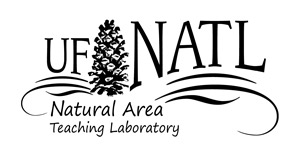| UF Academic Use | Public Use | Family Fun and K-12 Education |

Pre-1994 history of NATL's hammock ecosystem
When NATL-west was established in 1994, its hammock vegetation showed the effects of previous disturbances.
The portion north of Division Trail (the part now in NATL's public area and home to the Hammock Nature Trail) had clearly been disturbed more recently and more severely than the portion to the south. Most of the northern portion had an overstory of loblolly pines that were 40-50 years old and an understory of hammock hardwoods. Aerial photographs made by the Soil Conservation Service beginning in 1937 (see aerial photographs and post-WWII history of NATL
) indicate that only the southeast extreme of NATL-west's public-area hammock existed when the University of Florida acquired the land in 1944. They also show trails made by livestock. In other words, most of this part of NATL's hammock had been cleared and had become a grazed field before it was abandoned to succession ca 60 years ago.
The southern portion of NATL-west's hammock ecosystem and the southeast corner of the northern portion have limestone near the surface and the aerial photographs give no indication of earlier clearing. In 1994 these parts of NATL had many broadleaved trees of impressive diameters-most notably pignut hickories and sweet gums. Scattered among the mature hardwoods were loblolly pines that were of approximately the same age and large enough to have been established before 1910. Incremental boring of the still surviving loblollies should better define the date. The only one dated thus far was estimated to have germinated in 1894 (see Jeff Morton's final report of his Minigrant project). Because loblollies become established in hammocks only where sunlight reaches the forest floor, something must have taken out canopy trees at numerous spots at about the same time. Candidate disturbances are major windstorms and logging of the most valuable trees. A windstorm of sufficient magnitude was Hurricane 4 of 1896 that came ashore at Cedar Key and left a path of destruction northeastward to near Jacksonville. One report claimed, "The timber interests are ruined, and not a tree suitable for a saw-log remains between the Waccasassa and Suwanee Rivers."1 Much later, during the period that the northern portion of NATL's hammock was exposed to grazing, the southern portion was exposed to browsing.
Between 1944, when the State purchased the land that includes NATL, and 1994, when NATL was founded, a sizable hobo camp, accessed by a path from the parking lot of Bennigan's Restaurant on Archer Road, was established in the hammock between Gasline Trail and NATL's south boundary. Among the earliest actions of the Natural Area Advisory Committee was the cleanup of this campsite (in grid block F11 or G11) and the erection of a new field fence along NATL's south border. (The existing fence was on the ground where the path from Bennigan's crossed into NATL.) In 1990, five college students living near UF were murdered between August 23 and 26. Danny Rollins, the murderer, camped in the hobo camp during his grisly spree.
1Alvin F. Oickle. 2009. The Cedar Keys Hurricane of 1896, History Press, Charleston. p.66.


